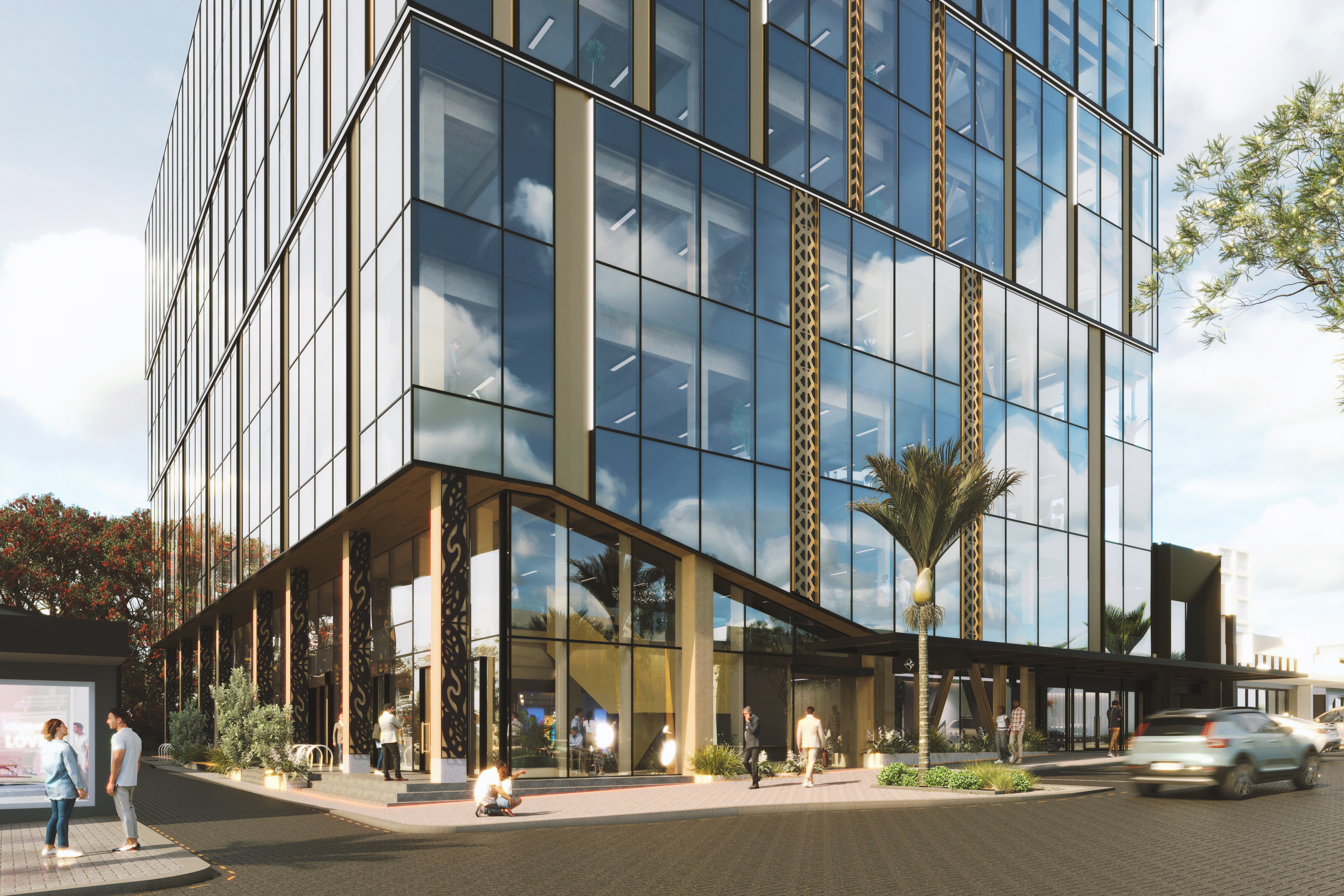The largest mass timber office building in Aotearoa tells a new story about sustainability and construction. The industry-leading project has been awarded 6 Green Stars.
Essentials
Name: 90 Devonport Road (working name only)
What: eight-storey mass timber building; open plan offices; temporary council chambers; tenanted ground floor café; 10,400 square metres
Where: Tauranga CBD (Te Papa Peninsula) ; elevated site; views to Tauranga Moana; site is a former carpark
Details: design aligns with Te Papa design principles developed by tangata whenua for the city’s CBD; the building features local mana whenua artistic expressions from Te Kahui Tōī including tuneable facade lighting reflecting the form of Mauao (Mt Maunganui) and 11 metre facade art panels
Tenant: Tauranga City Council (15 year lease); Willis Bond has worked in partnership with TCC to deliver a purpose-built facility with an integrated fitout
Daily occupancy: approximately 700 council administration staff
Project Snapshot
Owner: Willis Bond
Architect: Warren and Mahoney
Project GSAP: Tim Howarth, Beca
Main contractor: LT McGuinness
Building Services Engineer: Beca
Fire Engineer: Beca
Structural Engineer: Dunning Thornton
Project status: design phase 2021, under construction; completion scheduled for mid 2025
Project certification: 6 Green Star Design & As Built NZv1.0 Design rating (February 2024); targeting Gold WELL Certification (for Tauranga City Council) and NABERSNZ ratings
![[Marketing]_9182_90 Devonport Rd Tauranga_Elevated Elevation_Day_V06](https://nzgbc.org.nz/hs-fs/hubfs/%5BMarketing%5D_9182_90%20Devonport%20Rd%20Tauranga_Elevated%20Elevation_Day_V06.jpg?width=8000&height=8000&name=%5BMarketing%5D_9182_90%20Devonport%20Rd%20Tauranga_Elevated%20Elevation_Day_V06.jpg)
The Tauranga City Council’s new headquarters are a game-changer.
When its previous administration building was vacated back in 2014 because of black mould, the council team was relocated to a range of leased locations across the city.
Now a decade later 90 Devonport Road brings the council back together under one roof in a building that’s hitting big industry benchmarks.
Using engineered timber in place of traditional concrete and steel elements the building’s entire super structure – all beams, columns and slabs - are made from laminated timber including LVL, CLT and glulam.
Only relatively small amounts of steel lateral bracing are incorporated for seismic loads.
The new civic asset has a package of impressive data – the building has half the upfront carbon of a traditional steel and concrete office block, and its façade and building services design are expected to deliver a 65 percent reduction in energy consumption against standard practice.
Building owner and property development company, Willis Bond, has already delivered prominent Green Star projects including Tākina Convention & Exhibition Centre in Wellington and the highly sustainable Blue Mountains Campus in Upper Hutt.
Chairman, Mark McGuinness, says a 6 Green Star target was in place from the outset.
“We felt that anything short would not align with the market-leading innovation of the mass timber at such a significant scale.”
“We consider Green Star as the highest and best recognised standard of quality and commitment to sustainability in the market – it has ensured thoughtfulness and discipline in our process through design and construction.”
![[Marketing]_9182_90 Devonport Rd Tauranga_Corner_Up_Dusk_V02](https://nzgbc.org.nz/hs-fs/hubfs/%5BMarketing%5D_9182_90%20Devonport%20Rd%20Tauranga_Corner_Up_Dusk_V02.jpg?width=4000&height=6000&name=%5BMarketing%5D_9182_90%20Devonport%20Rd%20Tauranga_Corner_Up_Dusk_V02.jpg)
Warren and Mahoney project architect, Divya Purushotham, says delivering a large-scale mass timber commercial building with ambitious sustainable outcomes to address climate change was a significant design driver.
A sustainability framework was developed to advocate for a new means of construction and help realise a ground-breaking result.
With the local industry in its early days of understanding the technologies and capacities of mass timber it was critical the building’s design retained simplicity and regularity to achieve commercial feasibility.
That feasibility factor has been a key consideration for Beca GSAP, Timothy Howarth.
“This project showcases it’s possible to use mass timber for low to mid-rise commercial buildings in Aotearoa and demonstrates we can use sustainably harvested timber from our local forests and processed in our local sawmills- supporting local employment and regional economic growth.”
He says 90 Devonport Road shows with the right approach the technical and financial hurdles associated with mass timber buildings - fire engineering, structural design and uplift in cost – can be overcome.
Timber for the project was sourced from Rotorua and Nelson and LT McGuinness project manager, James Haworth, says the building was assembled like a Lego set.
“It’s been a very unique way to build a structure with everything being modelled and prefabricated off-site then brought to site on trucks.”
That off-site fabrication of mass timber components and the modular nature of the system has meant high speed construction with little dust and a quieter, cleaner work environment for those on site.
Warren and Mahoney says the trailblazing mass timber project has been defined by creative solutions and problem-solving.
“The leadership, innovation and benchmarks offered by 90 Devonport Rd come from a collective of people around the table who challenged and encouraged different ways of thinking,” says Divya Purushotham.
Willis Bond senior development manager, Will Ellison, says 90 Devonport Road connects people with each other and the environment in ways a traditional building does not do.
“I’ve taken multiple tours through the building and the first thing most people do is reach out and touch the timber columns. You simply don’t see that with steel.”
Green features include:
- mass timber structural frame and flooring system
- curtain wall facade and an HVAC system - 2-pipe chilled water fan coil units with electric reheat.
- rainwater harvesting system/water efficient fittings – 40 percent reduction in potable water consumption
- hot water production, space heating and cooking systems are fossil fuel-free
- high quality internal environment – high ventilation rates, access to views and daylight, thermal comfort, healthy material specification
- ventilation system operates with no heating or cooling with thermal wheel to recover energy otherwise wasted
- over 95 percent of the timber (by cost) re-used or certified by a forest certification scheme
- 70 percent target - recycling or reuse of construction waste
- Life Cycle Assessment undertaken to inform the project on the extent of its environmental impact
- extensive EOT facilities
